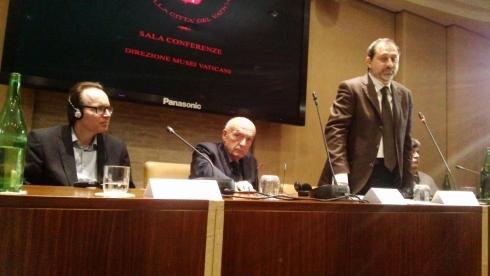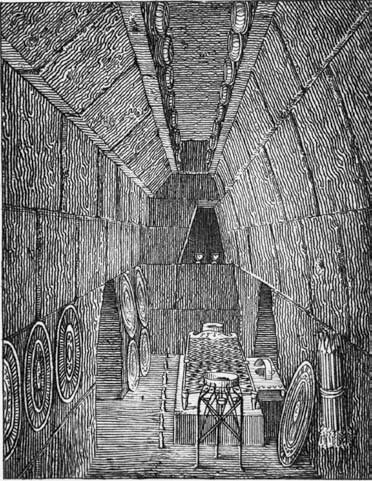On April 4, 2013, the latest version of the Etruscanning 3D application was inaugurated in the Museo Gregoriano Etrusco in the Vatican Museums. The installation consists of a non-interactive film that is displayed in Room 2 where the Regolini-Galasssi objects are displayed, and an interactive 3D application with a natural interaction interface in Room 16. On multiple screens within the Vatican Museums, an introduction film to the application was shown.

Part of the Etruscanning team at the entrance of the Vatican Museums in front of the Etruscanning promo film (from left to right: Wim Hupperetz, René van Beek, Daniel Pletinckx, Christie Ray, Judith Vos, photo: Veerle Delange)

Many people attended the project presentation at the press conference room of the Vatican (photo: Daniel Pletinckx)
The inauguration of the installation was proceeded by presentations by the involved project partners, introduced by Antonio Paolucci, director of the Vatican Museums. Maurizio Sannibale, curator of the Gregorian Etruscan Museum, provided an introduction to the Regolini-Galassi tomb, and Wim Hupperetz, director of the Allard Pierson Museum and Etruscanning project coordinator, presented the project and the resulting publication.

Presentations were given by Antonio Paolucci (middle), Wim Hupperetz (left) and Maurizio Sannibale (right) (photo: Sofia Pescarin)
Salvatore Garraffo, director of CNR-ITABC, introduced the technology used in the project, while Eva Pietroni (CNR-ITABC) and Daniel Pletinckx (Visual Dimension bvba) explained the natural interaction interface, the digitisation of the museum objects and their digital restoration. Rita Cosentino (Soprintendenza all’Etruria Meridionale) and Vincenzo Bellelli (CNR-ISMA) provided a wider context for the Regolini-Galassi tomb and its objects.

Introduction film to the virtual reconstruction of the Regolini-Galassi tomb in its museum room (photo: Daniel Pletinckx)
After the presentations, the installation was inaugurated. In Room 2, where all objects of the Regolini-Galassi tomb are on display, a large screen shows the virtual reconstruction of the tomb with the digitally restored objects integrated in the tomb. In this way, the objects are shown in their original context in their original state, providing the visitors with an even better appreciation and understanding of the objects. The film invites the visitors also to use the interactive application, which is located in nearby room (room 16), due to the lack of sufficient space in the Regolini-Galassi room.

Interactive Etruscanning application using a natural interaction interface (photo: Daniel Pletinckx)
In the interactive application, the visitor navigates through the tomb and selects objects and their related stories through simple, natural gestures (such as right arm forward for moving forward) detected by a Kinect camera. When starting, the visitor can select a language (Italian, English, Dutch) and can practice the navigation and object selection when approaching the virtual tomb. Once inside, the visitor can explore the entrance, antechamber, cella, left and right niche of the tomb with all its objects in place, select specific objects and listen to the stories connected to the objects. This video shows how it works in English or Italian.
Many newspapers, magazines and news websites covered this inauguration. To name a few: La Repubblica, Il Messagero, Radio Vaticana, Gizmondo, Buone Notizie, Reset Italia, Good News, ArcheoMatica, …
This blog is part of the Etruscanning 3D project, that is being partially funded with support from the European Commission. This blog reflects the views only of the author, and the Commission cannot be held responsible for any use which may be made of the information contained therein.

Tags: 3D virtual reconstruction, 3D visualisation, 3D VR, Allard Pierson museum, CNR-ITABC, digital restoration, Etruscan, Etruscan tombs, Etruscanning, Etruscans, interactive museum applications, Kinect, natural interaction, real time visualisation, Regolini Galassi tomb, V-MusT.net, Vatican museum, virtual reconstruction, VR












